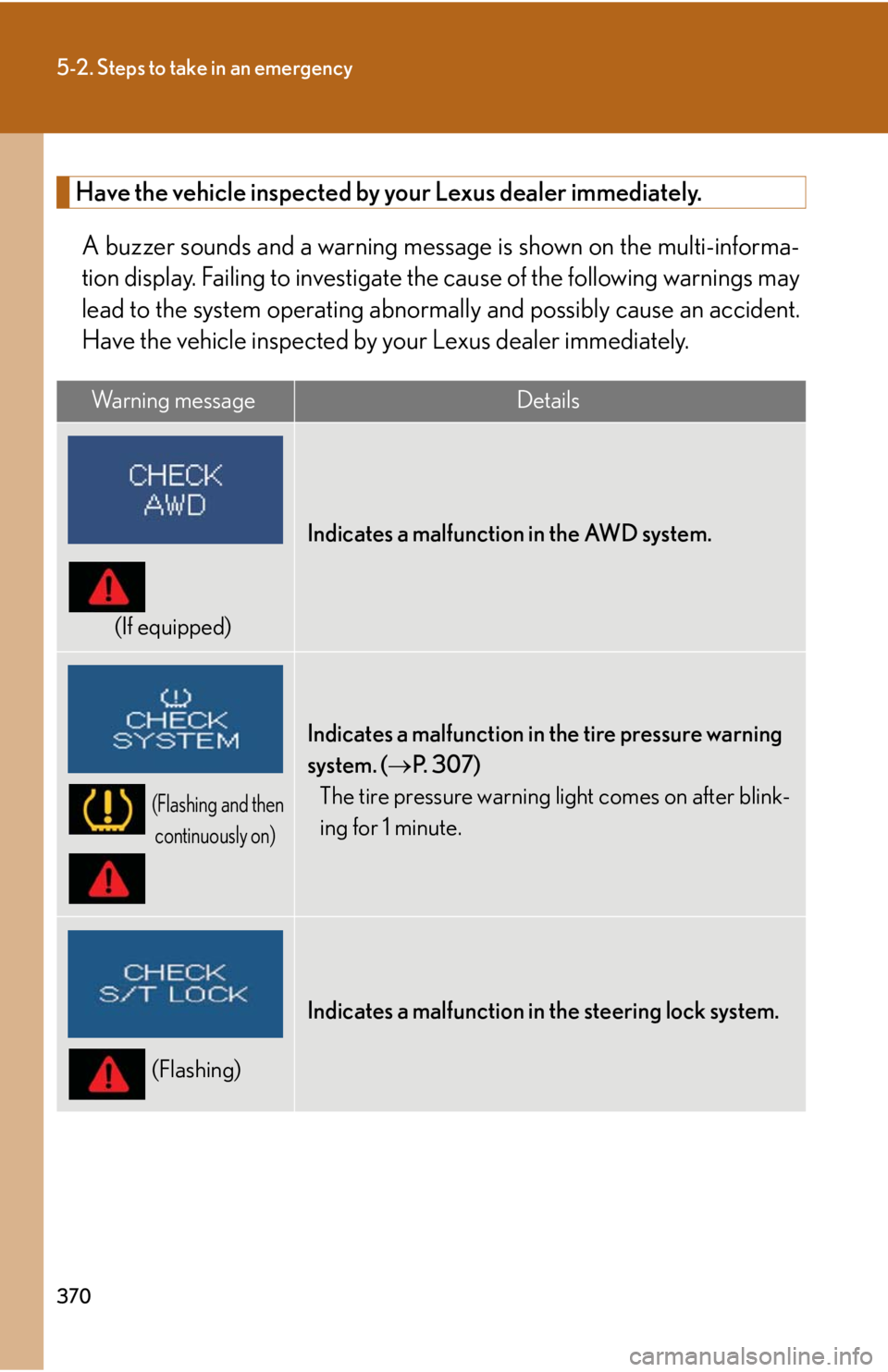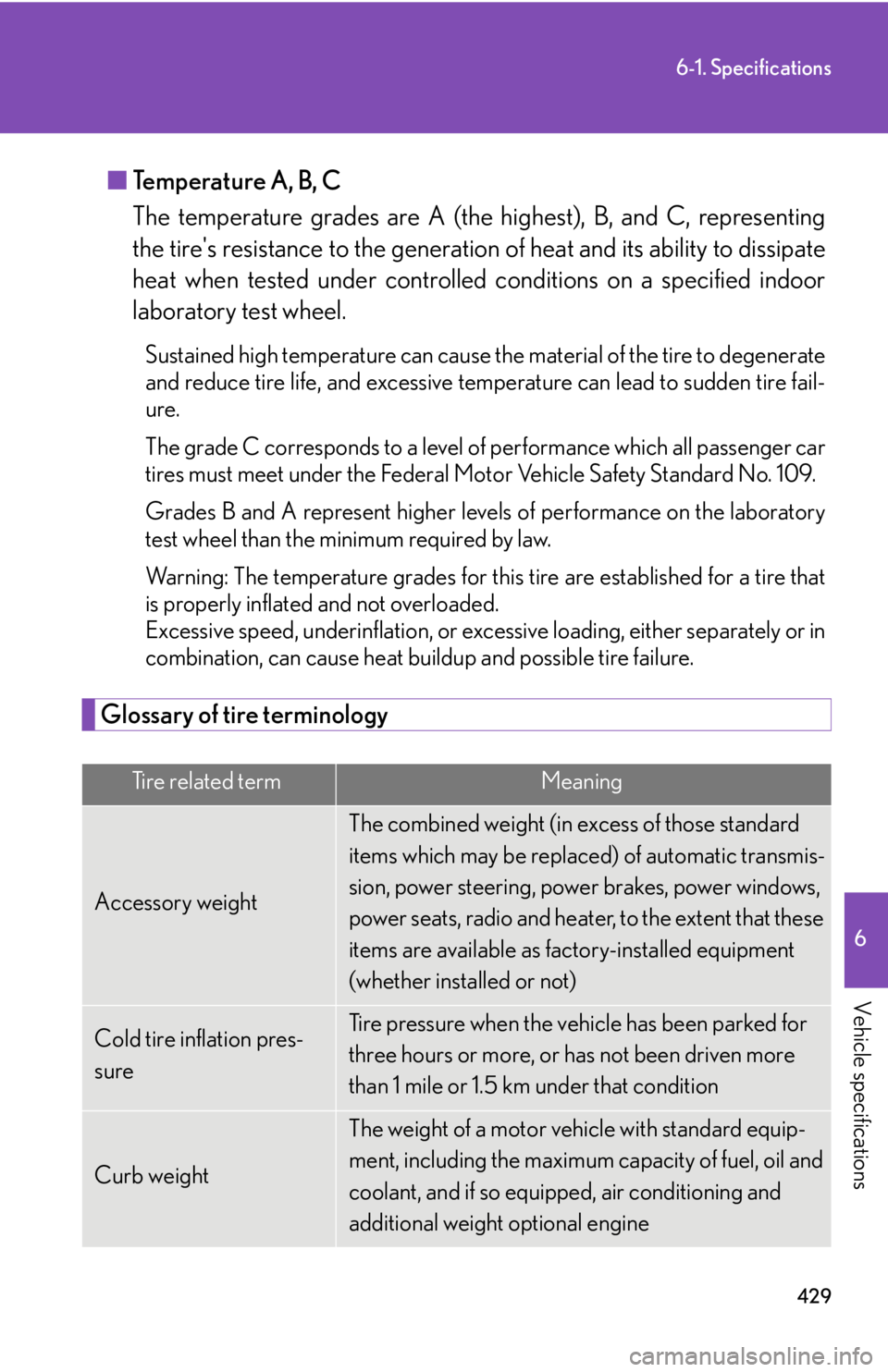warning Lexus IS250 2008 Using the air conditioning system and defogger / LEXUS 2008 IS250 (OM53699U) Workshop Manual
[x] Cancel search | Manufacturer: LEXUS, Model Year: 2008, Model line: IS250, Model: Lexus IS250 2008Pages: 464, PDF Size: 6.61 MB
Page 369 of 464

5
When trouble arises
369
5-2. Steps to take in an emergency
If a warning message is displayed
Stop the vehicle immediately.A buzzer sounds and a warning message is shown on the multi-informa-
tion display. The following warnings indicate the possibility of damage to
the vehicle that may lead to an accident. Immediately stop the vehicle in a
safe place and contact your Lexus dealer.
Wa r n i n g m e s s a g eDetails
(Flashing)
Indicates an abnormal engine oil pressure.
The warning light may turn on if the engine oil pres-
sure is too low.
If a warning is shown on the multi-information display, stay calm and per-
form the following actions:
Master warning light
The master warning light also
comes on or flashes in order to
indicate that a message is cur-
rently being displayed on the
multi-information display.
Multi-information display
If any of the warning li ght turns on again after performing the following
actions, contact your Lexus dealer.
Page 370 of 464

370
5-2. Steps to take in an emergency
Have the vehicle inspected by your Lexus dealer immediately.
A buzzer sounds and a warning message is shown on the multi-informa-
tion display. Failing to investigate the cause of the following warnings may
lead to the system operating abnormally and possibly cause an accident.
Have the vehicle inspected by your Lexus dealer immediately.
Wa r n i n g m e s s a g eDetails
(If equipped)
Indicates a malfunction in the AWD system.
(Flashing and then
continuously on)
Indicates a malfunction in the tire pressure warning
system. ( P. 3 0 7 )
The tire pressure warning light comes on after blink-
ing for 1 minute.
(Flashing)
Indicates a malfunction in the steering lock system.
Page 372 of 464

372
5-2. Steps to take in an emergency
Have the vehicle inspected by your Lexus dealer immediately.
Failing to investigate the cause of th e following warning may lead to the
system operating abnormally and possibly cause an accident. Have the
vehicle inspected by your Lexus dealer immediately.
Wa r n i n g m e s s a g eDetails
Indicates a malfunction in the TRAC, VSC or hill-
start assist control systems.
Page 373 of 464

5
When trouble arises
373
5-2. Steps to take in an emergency
Follow the correction procedures.A buzzer sounds and a warning message is shown on the multi-informa-
tion display. After taking the spec ified steps to correct the suspected
problem, check that the warning message turns off.
Wa r n i n g m e s s a g eDetailsCorrection procedure
Indicates that one or
more of the doors is not
fully closed.
The system also indi-
cates which doors are
not fully closed.
flashes and a
buzzer sounds to indi-
cate that one or more of
the doors is not fully
closed (with the vehicle
having reached a speed
of 3 mph [5 km/h]).
Make sure that all of the
doors are closed.
Indicates that the hood is
not fully closed.
flashes and a
buzzer sounds to indi-
cate that hood is not fully
closed (with the vehicle
having reached a speed
of 3 mph [5 km/h]).
Close the hood.
Page 377 of 464

5
When trouble arises
377
5-2. Steps to take in an emergency
Wa r n i n g m e s s a g eDetailsCorrection procedure
(Flashing and then con-tinuously on)
(Flashing)
(If equipped)Indicates that the radar
cruise control system is
unable to judge vehicle-
to-vehicle distance.
• Switch the driving mode to either the normal or
power mode.
• If the windshield wipers
are on, turn them off or
set them to either the
intermittent or the slow
mode.
(Flashing)
(If equipped)
Indicates that your vehi-
cle is nearing the vehicle
ahead (in radar cruise
mode).
Slow the vehicle by apply-
ing the brakes.
■Changing the engine oil (U.S.A. only)
Make sure to reset the oil change system. ( P. 2 9 5 )
■Warning light display in radar cruise mode
In the following cases, the warning light may not be displayed even if vehicle-to-
vehicle distance closes.
●When your vehicle and the vehicle ahead are traveling at the same speed or the
vehicle ahead is traveling more quickly than your vehicle
●When the vehicle ahead is traveling at a very low speed
●Immediately after cruise control speed is set
●At the instant the accelerator pedal is depressed
Page 378 of 464

378
5-2. Steps to take in an emergency
Follow the correction procedures.After taking the specified steps to co rrect the suspected problem, check
that the warning light turns off.
Interior
buzzerExterior buzzerWa r n i n g m e s s a g eDetailsCorrection
procedure
Once
(Comes on for 10 seconds.)
(Flashing)
Indicates that an
attempt was made
to start the engine
without the elec-
tronic key being
present, or the
electronic key was
not functioning
normally.
Start the engine
with the elec-
tronic key
present.
*
Once3 times
(Flashing)
Indicates that a
door other than
the driver’s door
has been opened
or closed with the
“ENGINE START
STOP” switch in
any mode other
than OFF and the
electronic key
outside of the
detection area.
Confirm the loca-
tion of the elec-
tronic key.
Page 387 of 464

5
When trouble arises
387
5-2. Steps to take in an emergency
■The compact spare tire
●The compact spare tire is identified by the label “TEMPORARY USE ONLY”
on the tire sidewall.
Use the compact spare tire temporarily only in an emergency.
●Make sure to check the tire pressure of the compact spare tire. (P. 4 1 5 )
■When using the compact spare tire
As the compact spare tire is not equipped with the tire pressure warning valve and
transmitter, low inflation pressure of the spare tire will not be warned. Also, if you
replace the compact spare tire after the tire pressure warning light comes on, the
light remains on.
■If you have a flat rear tire on a road covered with snow or ice
Install the compact spare tire on the front of the vehicle. Perform the following steps
and fit tire chains to the rear tires.
Replace a front tire with the compact spare tire.
Replace the flat rear tire with the tire removed from the front of the vehi-
cle.
Fit tire chains to the rear tires.
■After completing the tire change
The tire pressure warning system must be reset. ( P. 3 0 8 )
STEP1
STEP2
STEP3
Page 390 of 464

390
5-2. Steps to take in an emergency
NOTICE
■Do not drive the vehicle with a flat tire.
Do not continue driving with a flat tire.
Driving even a short distance with a flat tire can damage the tire and the wheel
beyond repair.
■Be careful when driving over bumps with the compact spare tire installed on the
vehicle.
The vehicle becomes lower when driving with the compact spare tire compared to
when driving with standard tires. Be careful when driving over uneven road sur-
faces.
■Driving with tire chains and the compact spare tire
Do not fit tire chains to the compact spare tire.
Tire chains may damage the vehicle body and adversely affect driving performance.
■When replacing the tires
When removing or fitting the wheels, tire s or the tire pressure warning valve and
transmitter, contact your Lexus dealer as the tire pressure warning valve and trans-
mitter may be damaged if not handled correctly.
■To avoid damaging the tire pressu re warning valves and transmitters
Do not use liquid sealants on flat tires.
Page 428 of 464

428
6-1. Specifications
■DOT quality grades
All passenger vehicle tires must co nform to Federal Safety Require-
ments in addition to these grades. Quality grades can be found where
applicable on the tire sidewall between tread shoulder and maximum
section width.
For example: Treadwear 200 Traction AA Temperature A
■ Treadwear
The treadwear grade is a comparative rating based on the wear rate of
the tire when tested under controll ed conditions on a specified gov-
ernment test course.
For example, a tire graded 150 would wear one and a half (1 - 1 /2) times as
well on the government course as a tire graded 100.
The relative performance of tires de pends upon the actual conditions of
their use, however, and may depart significantly from the norm due to varia-
tions in driving habits, service practices and differences in road characteris-
tics and climate.
■ Traction AA, A, B, C
The traction grades, from highest to lowest, are AA, A, B and C, and
they represent the tire's ability to stop on wet pavement as measured
under controlled condit ions on specified government test surfaces of
asphalt and concrete.
A tire marked C may have poor traction performance.
Warning: The traction grade assigned to this tire is based on braking
(straight ahead) traction tests and does not include cornering (turning) trac-
tion.
Page 429 of 464

429
6-1. Specifications
6
Vehicle specifications
■Temperature A, B, C
The temperature grades are A (the hi ghest), B, and C, representing
the tire's resistance to the generation of heat and its ability to dissipate
heat when tested under controlled conditions on a specified indoor
laboratory test wheel.
Sustained high temperature can cause the material of the tire to degenerate
and reduce tire life, and excessive temperature can lead to sudden tire fail-
ure.
The grade C corresponds to a level of performance which all passenger car
tires must meet under the Federal Mo tor Vehicle Safety Standard No. 109.
Grades B and A represent higher levels of performance on the laboratory
test wheel than the minimum required by law.
Warning: The temperature grades for this tire are established for a tire that
is properly inflated and not overloaded.
Excessive speed, underinflation, or excess ive loading, either separately or in
combination, can cause heat build up and possible tire failure.
Glossary of tire terminology
Tire related termMeaning
Accessory weight
The combined weight (in excess of those standard
items which may be replaced) of automatic transmis-
sion, power steering, power brakes, power windows,
power seats, radio and heater, to the extent that these
items are available as factory-installed equipment
(whether installed or not)
Cold tire inflation pres-
sureTire pressure when the vehicle has been parked for
three hours or more, or has not been driven more
than 1 mile or 1.5 km under that condition
Curb weight
The weight of a motor vehicle with standard equip-
ment, including the maximum capacity of fuel, oil and
coolant, and if so equipped, air conditioning and
additional weight optional engine